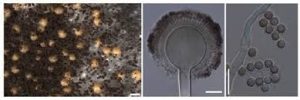Aspergillus section Nigri : New Discovery

Agharkar Research Institute in Pune, an autonomous institute of the Department of Science & Technology, recently identified two novel species of Aspergillus section Nigri (commonly known as black aspergillus), Aspergillus dhakephalkarii and Aspergillus patriciawiltshireae.
- Aspergillus section Nigri comprises filamentous fungi.
- It is a taxonomic group within the genus Aspergillus, characterized by its black-pigmented conidia (spores) and diverse metabolic capabilities.
- Their colonies usually appear black due to pigmented conidia.
- This section includes species that are significant in food spoilage, industrial applications, and human health, particularly in relation to mycotoxin production and opportunistic infections.
- While primarily sourced from soil, certain members of this group have been observed in various environments such as decaying organic material and on the surfaces of plants, contributing to food spoilage and diseases in maize, onions, grapes, and peanuts.
- Strains of Aspergillus section Nigri can colonize maize and small grains (which include wheat, triticale, spelt, etc.) during pre-harvest, harvest, or post-harvest storage
- Their ability to colonize diverse substrates underscores the importance of understanding their taxonomy, ecology, and potential impacts on agricultural, and food safety.
- Some strains of Aspergillus niger are known to secrete ochratoxins –mycotoxins which can give rise to nephrotoxicity and renal tumours in a variety of animal species and are potentially hazardous to human health through their consumption.
- Niger is one of the most widely used fungi in biotechnology.
- Production of citric acid, gluconic acid, and various enzymes (amylases, proteases, and cellulases).
- Used in food processing, pharmaceuticals, and bioengineering.




